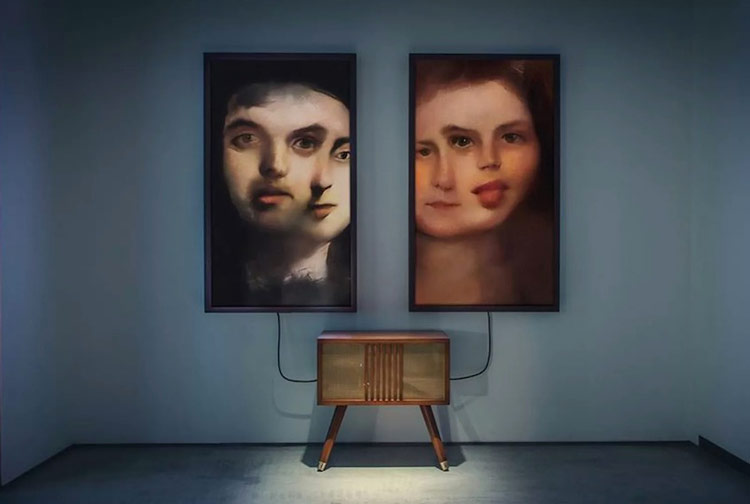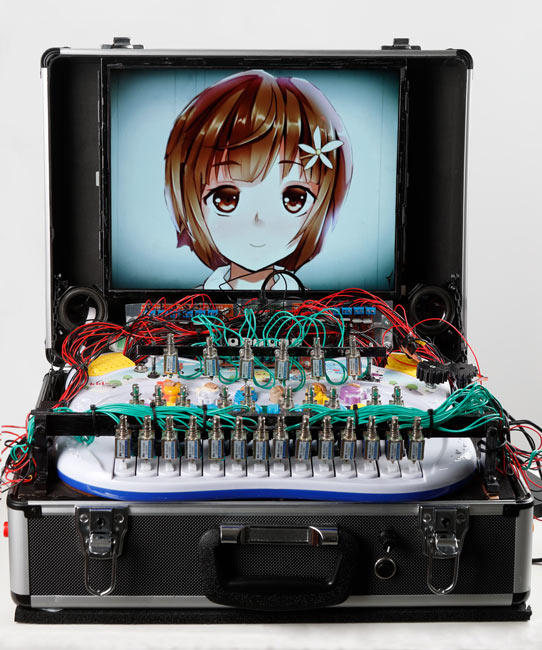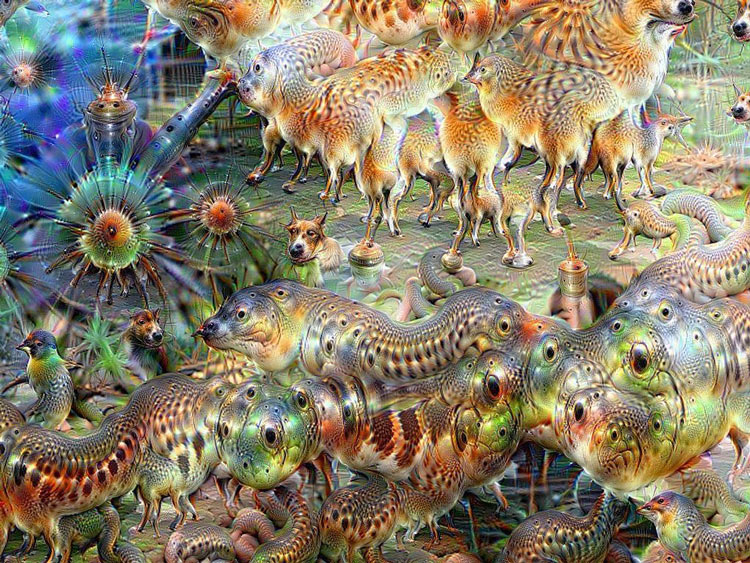
ART AND ARTIFICIAL INTELLIGENCE: THE END OF HUMAN CREATIVITY?
The uses of artificial intelligence (AI) extend to various aspects of our reality with potential applications ranging from the design of social behavior patterns, the prediction of economic fluctuations or the processing of data for the development of political measures in times of crisis. crisis. All of this shows us a futuristic future that we still see as a science fiction movie, perhaps largely due to the abundance of explanations and the use of terms that our minds are not yet able to transfer to a tangible plane. Furthermore, the union of the words “intelligence” and “artificial” to refer to these advances, in turn, generates a shadow of doubt about the value that human intervention continues to have in this context. Will we become expendable?

Pierre Fautrel, from the Obvious collective, “Edmond de Bellamy”. Portrait created with AI, 2018. (Image by Christie's)
The art world is no stranger to this reality and many venture that art made using artificial intelligence will be the great artistic movement of the 21st century. Although research into these methods began in the last decades of the last century, the issue gained popularity since in August 2018, a work made by artificial intelligence was auctioned for the first time at Christie's: Portrait of Edmond de Belamy (2018), which was sold. after more than six minutes of bidding for 380,000 euros. Shortly afterwards, the same thing happened with Memoirs of Passersby I (2019) by Mario Klingemann, auctioned at Sotheby's for 46,450 euros.
It is a fact that in recent years, art and artificial intelligence (AI) have begun to converge into an emerging creative field. AI has proven to be a valuable tool for artists seeking new forms of creative expression and exploration. From the production of algorithm-generated art to the interaction between humans and robots, AI has positioned itself as a tool to break new ground in the art world. One of the most notable applications of AI in the field of artistic practices is the production of generative or procedural art. Algorithms can learn artistic patterns and styles and then create new works of art based on that knowledge. This has led to the creation of a type of disruptive and surprising pieces. Additionally, AI is allowing artists to create interactive projects that change in real time based on interaction with viewers. For example, visitors to an exhibition can interact with a robot artist that uses AI to create unique works of art based on the conversation and gestures of the user-level experience.
Among the main drawbacks that arise when dealing with art made with artificial intelligence is the questioning of authorship, a concept that, in the territory of artistic production, is closely linked to creativity, talent or genius. The fear of being replaced by a machine raises suspicions. And possibly it is not so much because we recognize the technical boast of programming an algorithm capable of creating a work of art, but because of the insecurity produced in the viewer by not being able to distinguish whether a piece has been created by a human being or by a machine. It is a slippery slope, which undoubtedly affects some of the fundamental principles of our conception of art and creativity, since we have always considered that these are genuinely human qualities and impossible to replicate.

Mario Klingemann, "Memories of Passersby I." Installation of the work auctioned at Sotheby's. (Image from La Vanguardia)
In connection with this issue, other difficulties arise such as the recognition of authorship and the intellectual property rights associated with the work. Who is the true creator? Could an algorithm have its copyright recognized? In reality, the answer to these unknowns is simple, since such rights are only applicable to human beings. The future, however, remains to be written and perhaps we will reach a dystopian (or utopian) world where machines also enjoy this recognition. Until that happens, artificial intelligence will always be the result of authentically human design and programming work that gives rise to the codes and algorithms that are then used, in this case, to create art. Although the term “computational creativity” exists to refer to the study of the behavior of software whose performance and results can be considered creative, the situation has not yet arisen in which we doubt human creativity. In fact, in the 1950s the Turing test had been designed to analyze the degree of intelligence shown by software.
According to this method, if a set of objects, in which some computer-made and some man-made objects had been mixed, could not be distinguished from each other, then the intelligent software was working correctly. The original test consisted of a list of questions that the machine had to answer, something very similar to the interrogations represented in Blade Runner to identify the replicants.

Lars Dietrich, “Lily. “A Modernized Music Box”. SOLO Collection.
Today we know that the concept of intelligence is a complex notion and that it is determined by many factors of the individual, so giving a coherent answer to a given question would not be enough to determine if there is true intelligence. What's more, this adjective applied to today's programmed codes rather identifies the “autonomy” with which these software and algorithms work. In all of this, it is worth keeping in mind that to generate a new work, it is necessary to previously feed a database that allows the code to identify patterns and replicate them in a different creation. None of this can be done alone; From the choice of the image bank to the configuration of the specific coding system that is developed, whose syntax can guide the machine to identify movement or identify portraits, the human factor remains essential.

Work created with DeepDream. Program developed by Google researchers in 2015.
Although we are assailed by doubts and uncertainty, we must recognize that the incorporation of artificial intelligence opens a horizon of infinite possibilities that many creators want to enter. It is another window of exploration that contributes to expanding the limits of what is feasible and facilitates new languages in which the intervention of the viewer is often required. For some time now, and especially since the beginning of the new millennium, art has wanted to transcend its usual spaces and overcome the traditional contemplative relationship that it has maintained with the public for long periods of time. Now it is necessary for the message to penetrate through the active participation of the spectators, for it to be precisely the public who helps complete the speech or intervenes in some way in the final result of the works. And for this, artificial intelligence is a tool that allows us to explore our creativity to the extent we are able to allow it.

- December 23, 2025
Negative Space | Oscar Nominated Stop-Motion Animation Short Film

- December 23, 2025
Gaza's harsh winter..

- December 23, 2025
Space Drawing Perspective by Dongho Kim

- December 23, 2025
Victor Moriyama - Brazil

- December 23, 2025
Urban Art in Latin America

- December 23, 2025
Folk Art in Indigenous Communities of Latin America

- December 22, 2025
MACA Inaugurates Exhibitions of Fontana and Uruguayan Modern Art

- December 22, 2025
Graffiti as a Social and Political Language

- December 22, 2025
Graffiti – From the Street to Contemporary Art

- December 23, 2025
Urban Art in Latin America

- December 23, 2025
Folk Art in Indigenous Communities of L…

- December 22, 2025
Graffiti as a Social and Political Lang…

- December 22, 2025
Graffiti – From the Street to Contempor…

- December 21, 2025
Contemporary Art and New Visual Narrati…

- December 21, 2025
Latin American Visual Art as a Space of…

- December 20, 2025
Painting in the Americas: Origins and E…

- December 20, 2025
Key Latin American Artists in the Anti-…

- December 18, 2025
Artistic Movements and Expressions of R…

- December 18, 2025
Art and Anti-Imperialism in Latin Ameri…

- December 17, 2025
Visual Art in El Salvador: Between Memo…

- December 17, 2025
Visual Art in Cuba: A Window to Identit…

- December 16, 2025
Visual Art in Colombia: Diversity, Memo…

- December 16, 2025
Visual Art in Venezuela: Modernity, Ide…

- December 15, 2025
Visual Art in Paraguay: Tradition, Memo…

- December 14, 2025
Visual Art in Chile: Memory, Critique, …

- December 14, 2025
Visual Art in Bolivia: Ancestry, Resist…

- December 13, 2025
Visual Art in Peru: Ancestral Tradition…

- December 13, 2025
Visual Art in Argentina: Identity, Memo…

- December 11, 2025
The Visual Arts in Mexico: Between Myth…

- August 29, 2023
The history of Bolivian art

- February 19, 2024
Analysis and meaning of Van Gogh's Star…

- January 28, 2024
Culture and Art in Argentina

- September 25, 2023
What is the importance of art in human …

- September 23, 2023
What is paint?

- August 23, 2023
The 11 types of art and their meanings

- August 10, 2023
14 questions and answers about the art …

- September 23, 2023
Painting characteristics

- August 30, 2023
First artistic manifestations

- January 12, 2024
10 most beautiful statues and sculpture…

- September 23, 2023
History of painting

- March 26, 2024
The importance of technology in art1

- July 13, 2024
The impact of artificial intelligence o…

- March 26, 2024
Cultural identity and its impact on art…

- April 07, 2024
Graffiti in Latin American culture

- April 02, 2024
History visual arts in Brazil

- August 16, 2023
The 15 greatest painters in art history

- April 06, 2024
History of visual arts in Ecuador

- October 18, 2023
History of sculpture

- November 21, 2024
The Role of Visual Arts in Society

- February 19, 2024
Analysis and meaning of Van Gogh's Star…

- August 13, 2023
9 Latino painters and their great contr…

- August 23, 2023
The 11 types of art and their meanings

- August 10, 2023
14 questions and answers about the art …

- August 27, 2023
15 main works of Van Gogh

- August 29, 2023
The history of Bolivian art

- January 28, 2024
Culture and Art in Argentina

- November 06, 2023
5 Latin American artists and their works

- September 23, 2023
Painting characteristics

- September 23, 2023
What is paint?

- September 25, 2023
What is the importance of art in human …

- March 26, 2024
Cultural identity and its impact on art…

- August 30, 2023
First artistic manifestations

- December 18, 2023
10 iconic works by Oscar Niemeyer, geni…

- January 20, 2024
What is the relationship between art an…

- January 12, 2024
10 most beautiful statues and sculpture…

- August 24, 2023
The most famous image of Ernesto "Che" …

- October 30, 2023
Characteristics of Contemporary Art

- May 26, 2024
Técnicas de artes visuais

- August 22, 2023


